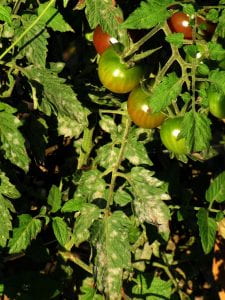- Alternaria stem canker
Symptoms: dark brown stem cankers with concentric rings that can girdle the plant.
- Bacterial speck | See factsheet for more information

Symptoms: tiny, dark brown to black spots with surrounding yellow halo. May result in leaf and plant stunting.
- Bacterial spot

Symptoms: dark brown, oval to elongated spots that coalesce to streaks. Considerable loss of lower foliage can occur.
- Early blight | See factsheet for more information (LIHREC)

Symptoms: on stems it appears as a lesion with a dark border and gray center. This can encompass and girdle the stem, causing death of lower canopy leaves.
- Gray leaf spot

Symptoms: spots appear on leaves with surrounding yellow halos. Affected leaves may turn partially or completely necrotic.
- Gray mold | See factsheet for more information (LIHREC)

Symptoms: large, light brown elliptical spots with gray fungal growth. Lesions can girdle the stem resulting in plant death.
- Late blight | See factsheet for more information

Symptoms: newer genotypes of late blight are more aggressive, especially on stems. Brown lesions form on stems and leaves with surrounding chlorotic halos. Plant death is common under wet, cool, and moderately warm temperatures.
- Leaf mold | See factsheet for more information

Symptoms: can result in considerable leaf defoliation but plant death is an unlikely result. Most common in greenhouses where humidity is high and air circulation is poor.
- Powdery mildew (Oidium) | See factsheet for more information (LIHREC)

Symptoms: affected plants show considerable defoliation but do not die as a result.
- Septoria leaf spot | See factsheet for more information (LIHREC)

Symptoms: dark, elongated spots develop on petioles and stems leading to loss of the lower canopy. Overwintering inoculum for the next season should be a concern.
- Target spot

Symptoms: stem lesions may eventually girdle the stem and result in plant death.
- White mold (Timber rot) | See factsheet for more information (LIHREC)

Symptoms: brown soft rot of stem at the crown or above. Rot becomes light gray and white, cottony fungal growth develops in moist weather. Hard, black, pea-like objects (sclerotia) eventually form, causing wilt and eventual plant death.
More information/prepared by:
- For more information, please contact:
Meg McGrath – mtm3@cornell.edu & Chris Smart – cds14@cornell.edu - Originally prepared for Vegetable MD Online by Thomas A. Zitter.


